List of Vice Presidents of the Philippines
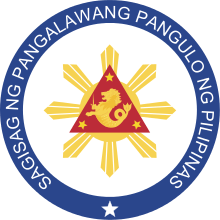
This is a complete list of Vice-Presidents of the Philippines, who were inaugurated as Vice-President of the Philippines following the ratification of a constitution that explicitly declared the existence of the Philippines. The inclusion of Mariano Trías in the list is disputed, for Trias was chosen as vice-president at the Tejeros Convention, and again as vice-president for the short-lived Republic of Biak-na-Bato, which was dissolved after the signing of the Pact of Biak-na-Bato and Aguinaldo's exile. Neither the reassumption of power by Emilio Aguinaldo when the revolution was resumed in May 1898 nor his formal proclamation and inauguration as President under the First Philippine Republic in 1899 were regimes that provided for a vice-presidency. The vice-presidency within the context of the Philippine government was formally created by the constitution in 1935.
Vice-presidents during the Commonwealth of the Philippines were under American sovereignty, and there was no office of vice-president during the Second Republic, considered to be a puppet government of Imperial Japan during World War II.
When Ferdinand Marcos declared martial law, the sitting vice-president, Fernando Lopez, was removed from the office. Marcos ruled without a vice-president until 1986. The 1973 constitution initially did not provide for a vice-president, but subsequent amendments restored the office. A vice-president was able to sit after the 1986 election when the Marcos-Arturo Tolentino ticket was proclaimed winners by the Batasang Pambansa.
Three vice-presidents succeeded to the presidency due to the death of presidents - Sergio Osmeña (1944), Elpidio Quirino (1948) and Carlos P. Garcia (1957). They did not nominate a new vice-president, since the 1935 constitution was silent on the matter; a new vice-president would sit after the results of following elections were known. Gloria Macapagal-Arroyo became president after the Supreme Court ruled that President Joseph Estrada resigned. Arroyo appointed Teofisto Guingona days after she ascended to power. The 1987 constitution mandated the President to nominate a vice-president from a member of the Congress of the Philippines, in which both houses vote separately for confirmation via a majority vote.
Fernando Lopez is the longest-serving vice-president, who served for a combined total of almost 11 years. Arturo Tolentino served 11 days before being deposed in the 1986 People Power Revolution. Noli de Castro was the first vice-president who was never a member of any political party but affiliated with the political coalition led by Lakas-CMD.
Key
The colors indicate the political party affiliation of each individual.
| Party | English name | Abbreviation | |
|---|---|---|---|
| Kapisanan ng Paglilingkod sa Bagong Pilipinas | Association for Service to the New Philippines | KALIBAPI | |
| Kilusang Bagong Lipunan | New Society Movement | KBL | |
| Laban ng Makabayang Masang Pilipino | Struggle of the Patriotic Filipino Masses | LAMMP | |
| Lakas ng Tao–Kabalikat ng Malayang Pilipino–Christian Muslim Democrats | People Power–Partner of the Free Filipino–Christian Muslim Democrats | Lakas–KAMPI–CMD | |
| Lakas ng Tao–National Union of Christian Democrats | People Power–National Union of Christian Democrats | Lakas–NUCD | |
| Liberal Party | Liberal | ||
| Nacionalista Party | Nationalist Party | Nacionalista | |
| Nationalist People's Coalition | NPC | ||
| Partido Demokratiko Pilipino–Lakas ng Bayan | Philippine Democratic Party–People's Power | PDP–Laban | |
| United Nationalist Alliance | UNA | ||
| United Nationalist Democratic Organization | UNIDO | ||
| Non-partisan | N/A | ||
Vice Presidents
| № | Vice President (Birth–Death) | Took office | Left office | Party | President | Era | |||
|---|---|---|---|---|---|---|---|---|---|
| 1 |  | Sergio Osmeña (1878–1961) | November 15, 1935 | August 1, 1944[1] | Nacionalista | Manuel L. Quezon | Commonwealth | ||
| Vacant August 1, 1944 - May 28, 1946 | Jose P. Laurel | Second Republic | |||||||
| Sergio Osmeña | Commonwealth | ||||||||
| 2 |  | Elpidio Quirino (1890–1956) | May 28, 1946 | April 17, 1948[1] | Liberal | Manuel Roxas | |||
| Third Republic | |||||||||
| Vacant April 15, 1948 - December 30, 1949 | Elpidio Quirino | ||||||||
| 3 |  | Fernando Lopez (1904–1993) | December 30, 1949 | December 30, 1953 | Liberal | ||||
| 4 |  | Carlos P. Garcia (1896–1971) | December 30, 1953 | March 18, 1957[1] | Nacionalista | Ramon Magsaysay | |||
| Vacant March 18, 1957 - December 30, 1957 | Carlos P. Garcia | ||||||||
| 5 |  | Diosdado Macapagal (1910–1997) | December 30, 1957 | December 30, 1961 | Liberal | ||||
| 6 | 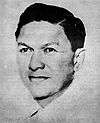 | Emmanuel Pelaez (1915–2003) | December 30, 1961 | December 30, 1965 | Liberal | Diosdado Macapagal | |||
| 7 |  | Fernando Lopez (1904–1993) | December 30, 1965 | September 23, 1972[2] | Nacionalista | Ferdinand Marcos | |||
| Abolished[3] September 23, 1972 - January 23, 1984 | Martial law era | ||||||||
| Fourth Republic | |||||||||
| Vacant January 23, 1984 - February 25, 1986 | |||||||||
| 8 |  | Salvador Laurel (1928–2004) | February 25, 1986[4] | June 30, 1992 | UNIDO | Corazon Aquino | |||
| Fifth Republic | |||||||||
| Nacionalista[5] | |||||||||
| 9 |  | Joseph Estrada (1937– ) | June 30, 1992 | June 30, 1998 | NPC | Fidel Ramos | |||
| 10 |  | Gloria Macapagal Arroyo (1947– ) | June 30, 1998 | January 20, 2001 | Lakas / KAMPI | Joseph Estrada | |||
| Vacant January 20, 2001 - February 7, 2001 | Gloria Macapagal Arroyo | ||||||||
| 11 | 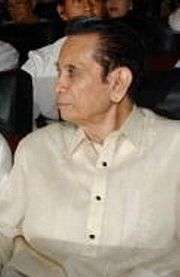 | Teofisto Guingona, Jr. (1928– ) | February 7, 2001[6] | June 30, 2004 | Lakas | ||||
| 12 | 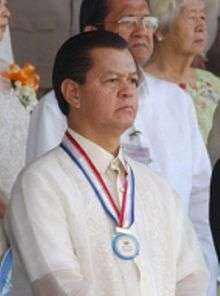 | Noli de Castro (1949– ) | June 30, 2004 | June 30, 2010 | Non-partisan[7] | ||||
| 13 |  | Jejomar Binay (1942– ) | June 30, 2010 | June 30, 2016 | PDP-Laban | Benigno Aquino III | |||
| UNA[8][9] | |||||||||
| 14 [10][11] | 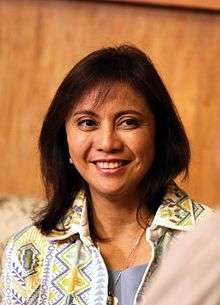 | Leni Robredo (1964– ) | June 30, 2016 | Incumbent | Liberal | Rodrigo Duterte | |||
Timeline

Unofficial Vice Presidents
Historians and other figures have identified the following people as having held the vice-presidency of a government intended to represent the Philippines, but their terms of office are not counted by the Philippine government as part of the presidential succession.
There is no office of the Vice President formed under the 1899 Malolos Constitution promulgated by President Emilio Aguinaldo. All previous national governments prior to 1899 are provisional or temporary in nature. Mariano Trias was elected as Vice President of the Tejeros Republic and Republic of Biak-na-Bato but was not included in the official roster of Philippine Vice Presidents.[12]
| Vice President (Birth–Death) | Took office | Left office | Party | President | Era | |||
|---|---|---|---|---|---|---|---|---|
 | Mariano Trías (1868–1914) | March 22, 1897[13] | December 14, 1897[14] | None[15] | Emilio Aguinaldo | Tejeros Convention | ||
| Republic of Biak-na-Bato | ||||||||
 | Francisco Carreón (1868–1939/41) | May 6, 1902 | July 14, 1906[16] | None[15] | Macario Sakay | Tagalog Republic | ||
| Benigno Aquino, Sr (1894–1947) | October 14, 1943 | August 17, 1945 | KALIBAPI |
José P. Laurel | Second Republic | |||
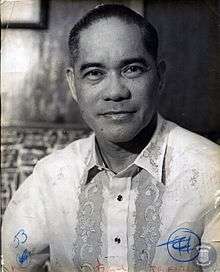 | Arturo Tolentino[17] (1910–2004) | February 16, 1986 | February 25, 1986[18] | KBL | Ferdinand Marcos | Fourth Republic | ||
See also
- President of the Philippines
- Vice President of the Philippines
- Prime Minister of the Philippines (presently defunct)
Notes
- "1973 Constitution of the Republic of the Philippines". Philippine Constitutions. Chan Robles Virtual Law Library. Retrieved 2006-10-26.
- "1987 Constitution of the Republic of the Philippines - Article VII". Philippine Constitutions. Chan Robles Virtual Law Library. Retrieved 2006-10-26.
References
- 1 2 3 Succeeded after the death of president.
- ↑ Term ended with the proclamation of martial law.
- ↑ The office of the vice president did not exist in the original, unamended 1973 Constitution, which was ratified on January 17, 1973. Amendments to Article VII restored the position.
- ↑ Assumed vice presidency by claiming victory in the disputed 1986 snap election.
- ↑ Laurel himself was a member of the Nacionalista Party, which aligned itself with the UNIDO ticket. In 1989, UNIDO dissolved and Laurel was elected president of the Nacionalistas.
- ↑ Nominated by President Arroyo and confirmed by Congress.
- ↑ Allied with the Koalisyon ng Katapatan at Karanasan sa Kinabukasan (Coalition of Truth and Experience for Tomorrow)
- ↑ Binay resigned from PDP-Laban in March 2014 due to an internal disputes.
- ↑ http://www.rappler.com/nation/70021-binay-una-political-party-2016
- ↑ Lira Dalangin-Fernandez; Loreen Ordoño (2016-05-30). "Congress proclaims Duterte and Robredo as duly elected president, vice president". InterAksyon.com. Retrieved 2016-06-02.
- ↑ Llanesca T. Panti (2016-05-30). "Congress Proclamation: Duterte President, Robredo VP". The Manila Times. Retrieved 2016-06-02.
- ↑ "Office of the Vice President". Official Gazette of the Republic of the Philippines. Retrieved 1 June 2016.
- ↑ Term began with his election as vice-president at the Tejeros Convention.
- ↑ Term ended with the dissolution of the Biak na Bato Republic.
- 1 2 Allied with the Magdalo faction of the revolutionary society Katipunan.
- ↑ Term ended with his capture by the American Forces .
- ↑ "Office of the Vice President". Official Gazette. Retrieved 2016-06-02.
Tolentino, however, was not recognized in our official roster of vice presidents as formalized by Resolution No. 2, s. 2013 dated March 11, 2013, signed by the National Historical Commission of the Philippines (NHCP)
- ↑ Term ended when Marcos was overthrown in the 1986 People Power Revolution